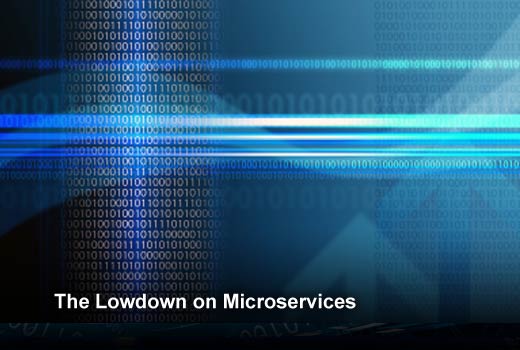The latest buzz in enterprise application development surrounds the emergence of microservices. Although this term continues to grow in popularity, there is still more to be learned about how these tiny powerhouses work and how they are changing the API environment.
To understand microservices, simply look to the name: micro-services. It is a new way of app building that breaks up application services into smaller, independent parts and functions.
With roots in SOA, DevOps and containers, microservices are seemingly part of architecture components we already know, but are unique in their flexible nature. Unlike traditional enterprise apps that are built as a monolithic piece of software, a microservices architectural style is an approach to developing applications as a suite of small services, running in its own process and communicating with lightweight protocols. The independent services, called microservices, are themselves not married to a specific language or platform. They can be easily and quickly adapted or altered to fit evolving application needs and functionality.
But what else is there to know about microservices? How should they be deployed and where do they fit best? As microservices continue to lead an enterprise app revolution, here are five things you need to know, presented by Akana, a leader in API management.

The Lowdown on Microservices
Click through for five points you need to know about the microservices revolution, as identified by Akana.

Microservices Fill in the Gaps
Microservices are the evolutionary result of a necessity for simplicity. Microservices were born as the solution to provide independent scalability, componentized services, and agility in response to business needs. This evolutionary architecture is succeeding where other service-based approaches have failed in the past. Developers can now build granular services from the bottom up, without being tied to previously rigid infrastructure. From inception to delivery, microservices have dramatically reduced the time required to have a finalized application on the market.

Microservices Bring Together the Best of SOA, DevOps and Containerization
Although microservices are a descendant of SOA (service-oriented architecture), they are not the same. Microservices have moved past the bulky middleware ESBs (enterprise service buses) that SOA relied on, but kept the efficiency that comes with reusable software. Similar to DevOps, microservices provide agility, and like containerization, they provide scalability within application development, deployment and management.

Microservices Are Developer Friendly
Using microservices, developers can experience increased productivity, reduced development time and greater control over functions, as the same microservices can be utilized across a variety of applications. The microservices architecture provides developers greater freedom since microservices are not tied to any specific language or code; they are free to pick whatever frameworks are best suited for that service.

Microservices Never Miss a Beat
In today’s fast-paced, demanding digital world, users have come to expect immediacy as a basic requirement – in addition to perfect functionality. Thanks to microservices, applications can now be constantly and seamlessly updated and improved. The microservices infrastructure enables scheduled updates to provide customers with new, fully functional applications on a continuous basis – made possible by the ability to turn on and off specific parts of their applications to restore and again deploy, all without any down time. For businesses needing to quickly react to shifting market trends and incorporate changes to fit business needs and user demands, microservices are key.

Microservices Are Fault-Tolerant
Microservices architecture creates a division of labor that provides a safeguard when it comes to application failure. There can be hundreds of microservices running on a single server. If they go bad, they can easily be thrown out. Even if one microservice is faulty or malfunctions, the whole application will not suffer, allowing business to continue despite the hiccup.
Learn more about microservices: “Microservices: Why Should Digital Businesses Care?“














